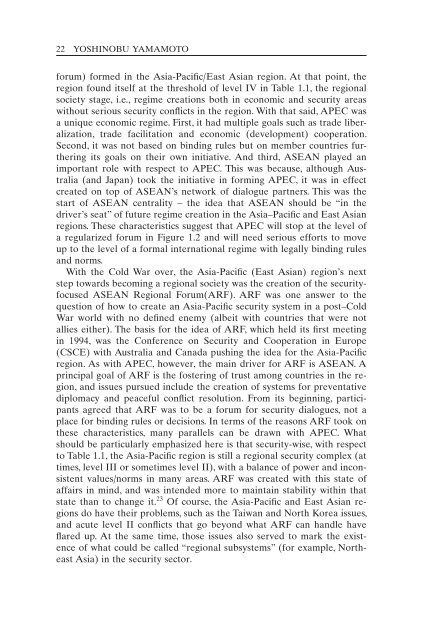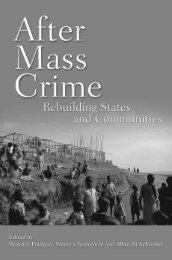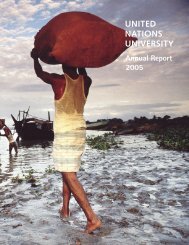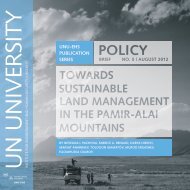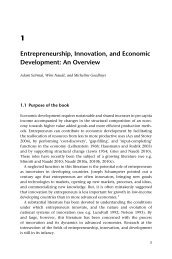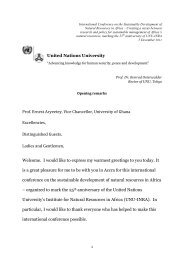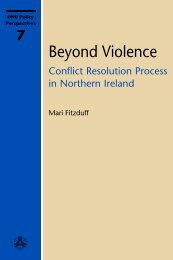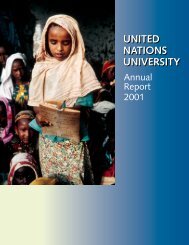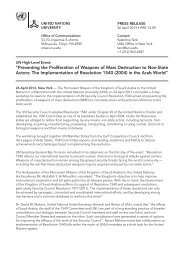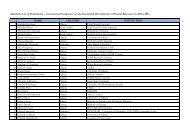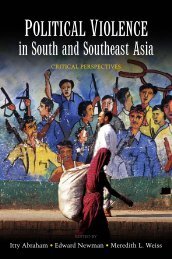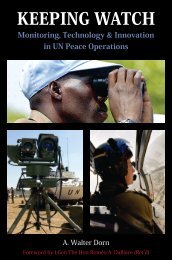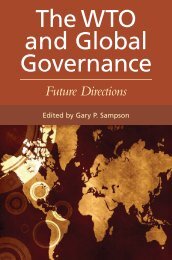Sample Chapter - United Nations University
Sample Chapter - United Nations University
Sample Chapter - United Nations University
You also want an ePaper? Increase the reach of your titles
YUMPU automatically turns print PDFs into web optimized ePapers that Google loves.
22 Yoshinobu Yamamoto<br />
forum) formed in the Asia-Pacific/ East Asian region. At that point, the<br />
region found itself at the threshold of level IV in Table 1.1, the regional<br />
society stage, i.e., regime creations both in economic and security areas<br />
without serious security conflicts in the region. With that said, APEC was<br />
a unique economic regime. First, it had multiple goals such as trade liberalization,<br />
trade facilitation and economic (development) cooperation.<br />
Second, it was not based on binding rules but on member countries furthering<br />
its goals on their own initiative. And third, ASEAN played an<br />
important role with respect to APEC. This was because, although Australia<br />
(and Japan) took the initiative in forming APEC, it was in effect<br />
created on top of ASEAN’s network of dialogue partners. This was the<br />
start of ASEAN centrality – the idea that ASEAN should be “in the<br />
driver’s seat” of future regime creation in the Asia–Pacific and East Asian<br />
regions. These characteristics suggest that APEC will stop at the level of<br />
a regularized forum in Figure 1.2 and will need serious efforts to move<br />
up to the level of a formal international regime with legally binding rules<br />
and norms.<br />
With the Cold War over, the Asia-Pacific (East Asian) region’s next<br />
step towards becoming a regional society was the creation of the securityfocused<br />
ASEAN Regional Forum(ARF). ARF was one answer to the<br />
question of how to create an Asia-Pacific security system in a post–Cold<br />
War world with no defined enemy (albeit with countries that were not<br />
allies either). The basis for the idea of ARF, which held its first meeting<br />
in 1994, was the Conference on Security and Cooperation in Europe<br />
(CSCE) with Australia and Canada pushing the idea for the Asia-Pacific<br />
region. As with APEC, however, the main driver for ARF is ASEAN. A<br />
principal goal of ARF is the fostering of trust among countries in the region,<br />
and issues pursued include the creation of systems for preventative<br />
diplomacy and peaceful conflict resolution. From its beginning, participants<br />
agreed that ARF was to be a forum for security dialogues, not a<br />
place for binding rules or decisions. In terms of the reasons ARF took on<br />
these characteristics, many parallels can be drawn with APEC. What<br />
should be particularly emphasized here is that security-wise, with respect<br />
to Table 1.1, the Asia-Pacific region is still a regional security complex (at<br />
times, level III or sometimes level II), with a balance of power and inconsistent<br />
values/norms in many areas. ARF was created with this state of<br />
affairs in mind, and was intended more to maintain stability within that<br />
state than to change it. 23 Of course, the Asia-Pacific and East Asian regions<br />
do have their problems, such as the Taiwan and North Korea issues,<br />
and acute level II conflicts that go beyond what ARF can handle have<br />
flared up. At the same time, those issues also served to mark the existence<br />
of what could be called “regional subsystems” (for example, Northeast<br />
Asia) in the security sector.


